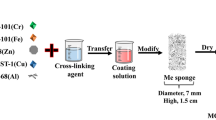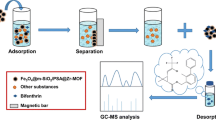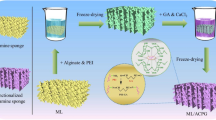Abstract
Minamata disease is caused by methylmercury, which is produced by microorganisms from inorganic mercury ions, Hg(II), in the aquatic environment. Adsorption is a feasible method to remove Hg(II) from waters, but there are some drawbacks when using conventional adsorbents, for example, tedious solid–liquid separation, slow response, and excessive residual levels of mercury. In this work, a novel spongy adsorbent has been developed for Hg(II) removal via surface functionalization of melamine formaldehyde sponge by glutathione. This material mimics a natural antidote that removes trace heavy metals in the human body. Results show that the functionalized sponge displays a 99.99% removal efficiency for low concentrations of Hg(II) of 10 mg/L. As a consequence, the residual Hg concentration is lower than 0.005 mg/L, which is slightly below the standard for total mercury in drinking water, of 0.006 mg/L, formulated by the World Health Organization, and much lower that the discharge regulation standard, of 0.01 mg/L, set by the ministry of environmental protection of China. Adsorption kinetic studies indicate that the functionalized sponge has a fast response. Indeed, the adsorption equilibrium can be reached within 10 min, and about 80% of total adsorption capacities are reached in 1 min. Moreover, the maximum adsorption capacity of the glutathione-functionalized sponge is as high as 240.02 mg/g, as shown by adsorption isotherm. Overall our findings disclose the great potential of the developed sponge adsorbent for rapid and efficient removal of Hg(II) from water.
Similar content being viewed by others
Explore related subjects
Discover the latest articles, news and stories from top researchers in related subjects.Avoid common mistakes on your manuscript.
Introduction
Heavy metal pollution is a global concern due to their environmental toxicity (Hakami et al. 2012; Liu et al. 2008; Nagajyoti et al. 2010). In particular, mercury is a toxic pollutant that should not enter the environment (Hadavifar et al. 2014). Mercury seriously endangers the health of human beings (Bansod et al. 2017; Vieira et al. 2017). Inorganic mercury ion, Hg(II), can be converted to methylmercury, the cause of the minamata disease, by microorganisms in waters. Methylmercury is a fat-soluble organic compound that can induce the enrichment of mercury in the food chain (Zahir et al. 2005).
Adsorption is a feasible technology to remove Hg(II) from waters, but conventional adsorbents such as nanopowders, hydrogels, and activated carbon have some deficiencies. For instance, the solid–liquid separation of nonmagnetic nanopowders is tedious, and magnetic nanopowders consume energy via a magnetic separation equipment; the adsorption equilibrium time of hydrogels is longer; and the removal of Hg(II) by activated carbon usually does not reach the discharge standards; and thus finer treatment is generally needed (Habineza et al. 2017) such as membrane separation (Kurniawan et al. 2006). Therefore, it is necessary to develop novel adsorbents for advanced treatment of Hg(II).
This work presents the design and synthesis of functionalized melamine formaldehyde sponge using glutathione. The functionalized spongy adsorbent was chosen for the following advantages compared to conventional adsorbents: spongy adsorbents are easy to separate; response speed is faster due to the porous structure of sponge; and residual concentrations are lower due to glutathione, which is a natural antidote for removing trace heavy metals in the human body (Cobbett and Goldsbrough 2002). Glutathione is an important antioxidant in plants, animals, fungi, and some bacteria and archaea. Glutathione is capable of preventing damage to important cellular components caused by reactive oxygen species such as free radicals, peroxides, lipid peroxides, and heavy metals (https://en.wikipedia.org/wiki/Glutathione).
Melamine formaldehyde sponges, usually named “melamine sponges,” have attracted widespread attention due to their excellent chemical stability (Ge et al. 2017; Ruan et al. 2014; Zhu et al. 2016). However, they actually lack active groups on their surface and hence are difficult to functionalize. Lee et al. (2007) found that polydopamine films can adhere onto the surfaces of various materials by self-aggregation of dopamine. Previous studies have also shown that polydopamine can form a coating on the surface of melamine sponges (Shang et al. 2016). From this prospect, we modified the surface of melamine formaldehyde sponge with polydopamine and then made subsequent functionalization using glutathione via Schiff base reaction.
Experimental
Material
Melamine sponge from Runde Trading Co. Ltd., China, has been cut into 1 × 1 × 1 cm3 cube. The melamine sponge is washed by water and ethanol for several times and then directly used. Absolute ethanol, ammonium hydroxide solution (NH4OH, 29%), dopamine hydrochloride, Tris–HCl (0.2 M), and glutathione are purchased from Sinopharm, China, and used directly.
Methods
Glutathione-functionalized sponge can be synthesized by the following procedure: 0.1 g of melamine sponge and 0.5 g dopamine hydrochloride were added into a solution of 50 ml ethanol, 100 ml water, and 0.5 ml NH4OH, and stirred for 6 h. The obtained sponge was water-washed three times. Then, glutathione was grafted on the polydopamine surface by a Schiff base reaction. After drying at 50 °C, melamine sponge was added into a solution of 1.0 g glutathione in 100 ml 10 mmol Tris–HCl (NH2C(CH2OH)3·HCl) and refluxed at 60 °C for 4 h, and then heating was stopped and stirring was performed for 15 h. The obtained sponge was water-washed three times and dried at 50 °C.
Information on chemical bonds was provided by Fourier transform infrared spectroscopy (Nicolet iS50). X-ray photoelectron spectroscopy (ESCALAB 250XI) was carried out at 150 W using Al Kα. The surface microstructures and elemental contents of sponge were revealed by scanning electron microscopy (Zeiss Supra55VP).
All adsorption experiments were using a thermostatic orbital shaker (HZQ–F160) at 120 rpm/30 °C. The inductively coupled plasma mass spectrometry was used for measuring Hg(II) concentration. And the adsorption capacities are calculated as follows:
where the adsorption capacity (Qe, mg/g) are obtained by the initial concentrations (C0, mg/L), final concentrations (Ce, mg/L) and volume (V, mL) of the solution, and the mass of sponge (m, g).
Results and discussion
Characterization of glutathione-functionalized sponge
The Fourier transform infrared spectra of melamine sponge and glutathione-functionalized sponge are shown in Fig. 1b. In particular, strong peaks at 973 and 810 cm−1 are ascribed to vibrations of the heterocyclic framework in the melamine sponge. Remarkably, after functionalization, the peaks at 3327 and 1326 cm−1 are shifted to 3300 and 1319 cm−1, assigned to stretching vibrations of N–H and aromatic C–N (Merline et al. 2013). This shift is attributed to the interference of chemical structure of N–H and C–N from polydopamine and glutathione. Additionally, the peak at 973 cm−1 is shifted to 977 cm−1 because of the influence of heterocyclic aromatic framework from polydopamine.
a Scheme of the formation of the glutathione-functionalized sponge. Fourier transform infrared spectra (b), X-ray photoelectron spectra [survey scan (c), C1s (d), N1s (e)] of melamine sponge and glutathione-functionalized sponge. Note the changes at 3327 and 1326 cm−1 attributed to the chemical structure of N–H and C–N. The peak of S 2p in the survey scan indicates that glutathione is loaded onto the surface of the melamine sponge
The X-ray photoelectron spectra of the melamine sponge and glutathione-functionalized sponge are presented in Fig. 1c–e. From the survey scan in Fig. 1c, the S2p peak indicates that glutathione is loaded onto the surface of the melamine sponge. After loading, a new peak appears at 288.37 eV in C1s spectrum in Fig. 1d, corresponding to the C=O bond, which implies that glutathione is successfully supported on melamine sponge (Stolz et al. 2016). Moreover, a new peak appears at 401.46 eV in Fig. 1e, corresponding to the C–N bond, which results from polydopamine and glutathione (Bae et al. 2016). Overall, the data confirm that glutathione-functionalized sponge was successfully synthesized.
The images of scanning electron microscopy and mapping of energy-dispersive spectroscopy for melamine sponge, dopamine-modified sponge, and glutathione-functionalized sponge are shown in Fig. 2. The structural framework of melamine sponge was smooth (Fig. 2a). In comparison, some particles of polydopamine are loaded onto the surface of melamine sponge in the dopamine-modified sponge (Fig. 2b), and more irregular particles (glutathione) are loaded on the surface of glutathione-functionalized sponge (Fig. 2c). Additionally, Fig. (2e–h) show distinctly that each element is well-distributed in glutathione-functionalized sponge. Significantly, elemental S is distributed evenly on the surface (Fig. 2h), which also confirms that glutathione is loaded on the surface of the melamine sponge supporting the results of Fourier transform infrared spectra (Fig. 1). Moreover, the sponge remains intact and porous after being supported, which is beneficial to adsorption. Note that the new S2p peak indicates that glutathione is loaded onto the surface of the melamine sponge.
Scanning electron microscopy images of melamine sponge (a), dopamine-modified sponge (b), glutathione-functionalized sponge (c) and (d). Elemental mapping of C, O, N, and S elements in glutathione-functionalized sponge for elements of C, O, N, and S (e)–(h). Note that the color changed from white to black. Porous microstructure remains intact after functionalized and elements are evenly distributed
Adsorption performance studies of glutathione-functionalized sponge
A simulated batch reactor is used for the adsorption experiment by using 10 mg of adsorbents to adsorb 50 ml of Hg(II) solution. The typical Hg(II) concentration was set at about 10 mg/L because Hg(II) levels in industrial waters are usually lower than 10 mg/L (Woodard and Curran, Inc. 2006).
The adsorption capacities of melamine sponge, dopamine-modified sponge, and glutathione-functionalized sponge are 1.02, 1.24 and 49.33 mg/g, respectively (Fig. 3a). The data prove that the adsorption capacity for Hg(II) is the main result of the introduction of glutathione. Furthermore, glutathione-functionalized sponge shows an extremely fast response in Fig. 3b. For instance, more than 80% of the total adsorption capacities can be achieved in 1 min, and more than 90% of the total adsorption capacities are reached in only 5 min. Moreover, the adsorption reached a state of equilibrium within 10 min. The final removal efficiency was close to 99.99% (Fig. 3b), and the residual concentration was less than 0.005 mg/L. The findings thus show that the glutathione-functionalized sponge is a quick responsive adsorbent with a unique removal rate. Compared with other adsorbents in Table 1, the performance of glutathione-functionalized sponge is better than most of other adsorbents in equilibrium time and removal rate.
a Comparison of adsorption capacities on melamine sponge, dopamine-modified sponge, and glutathione-functionalized sponge. b Removal efficiency for melamine sponge and glutathione-functionalized sponge. Fitting curves of c pseudo-first- and pseudo-second-order and d Langmuir and Freundlich models. Note that glutathione plays the major role in adsorption. And the maximum adsorption capacity is 240.02 mg/g
Adsorption kinetic studies of glutathione-functionalized sponge
Further study shows that glutathione-functionalized sponge is a potential Hg(II) adsorbent. Adsorption kinetic of glutathione-functionalized sponge was explored by pseudo-first- and pseudo-second-order models, which are expressed as follows:
where Qe and Qt represent the adsorption capacities (mg/g) at equilibrium and at t (min), respectively. k1 and k2 represent the rate constants of the pseudo-first-order (min−1) and pseudo-second-order (g/(mg·min)) models, respectively. The closeness between the value of the R-squared (R2) and 1 represents the matching degree between adsorption data and the fitting curves. Thus the R-squared of pseudo-second-order model (0.998) is more closes to 1 as presented in Fig. 3c, supporting that this process controlled by chemisorption mechanism.
Adsorption isotherm studies of glutathione-functionalized sponge
Adsorption isotherms, such as Langmuir and Freundlich models, are critical to understanding the mechanism of adsorption. They are usually expressed as follows:
where Qe and Ce represent the equilibrium adsorption capacity (mg/g) and the concentration of solution (mg/L), respectively. KL (L/g), KF (L/g), aL (L/mg) and n are the constants, respectively. As shown in Fig. 3d, obviously, the Langmuir isothermal model fits better to the curves suggesting that glutathione-functionalized sponge undergoes monolayer chemisorption of Hg(II) on its surface. Notably, the maximum adsorption capacity of glutathione-functionalized sponge reaches 240.02 mg/g as derived from Langmuir model.
Conclusion
A novel functionalized adsorbent was synthesized based on melamine formaldehyde sponge by a simple modification of polydopamine and further functionalization by glutathione. The new adsorbent sponge displays a highly efficient removal Hg(II), due to its orderly porous structure and functional groups, –NH2 and –SH. The adsorption equilibrium was reached within 10 min, and the residual concentration was less than 0.005 mg/L. Furthermore, adsorption kinetic studies suggest that adsorption is controlled by a chemisorption mechanism. Moreover, the maximum adsorption capacity was 240.02 mg/g as derived from Langmuir model. In addition, the developed spongy adsorbent not only has quick response speed and high removal rate but also is portable, user-friendly, and easy to separate.
References
Bae JY, Lee HJ, Choi WS (2016) Cube sugar-like sponge/polymer brush composites for portable and user-friendly heavy metal ion adsorbents. J Hazard Mater 320:133–142. https://doi.org/10.1016/j.jhazmat.2016.07.067
Bansod B, Kumar T, Thakur R et al (2017) A review on various electrochemical techniques for heavy metal ions detection with different sensing platforms. Biosens Bioelectron 94:443–455. https://doi.org/10.1016/j.bios.2017.03.031
Cobbett C, Goldsbrough P (2002) Phytochelatins and metallothioneins: roles in heavy metal detoxification and homeostasi. Annu Rev Plant Biol 53:159–182. https://doi.org/10.1146/annurev.arplant.53.100301.135154
Fang L, Li L, Qu Z et al (2017) A novel method for the sequential removal and separation of multiple heavy metals from wastewater. J Hazard Mater 342:617. https://doi.org/10.1016/j.jhazmat.2017.08.072
Ge J, Shi LA, Wang YC et al (2017) Joule-heated graphene-wrapped sponge enables fast clean-up of viscous crude–oil spill. Nat Nanotechnol 12:434–440. https://doi.org/10.1038/nnano.2017.3
Habineza A, Zhai J, Ntakirutimana T et al (2017) Heavy metal removal from wastewaters by agricultural waste low-cost adsorbents: hindrances of adsorption technology to the large scale industrial application—a review. Desalin Water Treat 78:192–214. https://doi.org/10.5004/dwt.2017.20581
Hadavifar M, Bahramifar N, Younesi H et al (2014) Adsorption of mercury ions from synthetic and real wastewater aqueous solution by functionalized multi–walled carbon nanotube with both amino and thiolated groups. Chem Eng J 237(2014):217–228. https://doi.org/10.1016/j.cej.2013.10.014
Hakami O, Zhang Y, Banks CJ (2012) Thiol-functionalised mesoporous silica-coated magnetite nanoparticles for high efficiency removal and recovery of Hg from water. Water Res 46:3913–3922. https://doi.org/10.1016/j.watres.2012.04.032
Kurniawan TA, Chan GYS, Lo WH et al (2006) Physico-chemical treatment techniques for wastewater laden with heavy metals. Chem Eng J 118:83–98. https://doi.org/10.1016/j.cej.2006.01.015
Lee H, Dellatore SM, Miller WM, Messersmith PB (2007) Mussel-inspired surface chemistry for multifunctional coatings. Science 318:426–430. https://doi.org/10.1126/science.1147241
Liu JF, Zhao ZS, Jiang GB (2008) Coating Fe3O4 magnetic nanoparticles with humic acid for high efficient removal of heavy metals in water. Environ Sci Technol 42:6949–6954. https://doi.org/10.1021/es800924c
Merline DJ, Vukusic S, Abdala A et al (2013) Melamine formaldehyde: curing studies and reaction mechanism. Polym J 45:413–419. https://doi.org/10.1038/pj.2012.162
Nagajyoti PC, Lee KD, Sreekanth TVM (2010) Heavy metals, occurrence and toxicity for plants: a review. Environ Chem Lett 8(3):199–216. https://doi.org/10.1007/s10311-010-0297-8
Oubagaranadin JU, SathyamurthyN Murthy ZV (2007) Evaluation of Fuller’s earth for the adsorption of mercury from aqueous solutions: a comparative study with activated carbon. J Hazard Mater 142(1–2):165. https://doi.org/10.1016/j.jhazmat.2006.08.001
Ruan CP, Ai KL, Li XB et al (2014) A superhydrophobic sponge with excellent absorbency and flame retardancy. Angew Chem Int Edit 53:5556–5560. https://doi.org/10.1002/anie.201400775
Shang B, Wang YB, Peng B et al (2016) Bioinspired polydopamine particles–assisted construction of superhydrophobic surfaces for oil/water separation. J Colloid Interface Sci 482:240–251. https://doi.org/10.1016/j.jcis.2016.07.081
Shi W, Tao S, Yu Y et al (2011) High performance adsorbents based on hierarchically porous silica for purifying multicomponent wastewater. J Mater Chem 21(39):15567–15574. https://doi.org/10.1039/C1JM12142A
Stolz A, Floch S, Reinert L, Ramos S et al (2016) Melamine-derived carbon sponges for oil–water separation. Carbon 107:198–208. https://doi.org/10.1016/j.carbon.2016.05.059
Vieira JCS, Braga CP, Oliveira GD et al (2017) Identification of protein biomarkers of mercury toxicity in fish. Environ Chem Lett 15(4):717–724. https://doi.org/10.1007/s10311-017-0644-0
Woodard, Curran, Inc (2006) 5–Waste characterization. Ind Waste Treat Handb 11(1):83–126. https://doi.org/10.1016/B978-075067963-3/50007-2
Yan R, Yang F, Wu Y et al (2011) Cadmium and mercury removal from non–point source wastewater by a hybrid bioreactor. Bioresour Technol 102(21):9927. https://doi.org/10.1016/j.biortech.2011.08.049
Zahir F, Rizwi SJ, Haq SK et al (2005) Low dose mercury toxicity and human health. Environ Toxicol Pharmacol 20:351–360. https://doi.org/10.1016/j.etap.2005.03.007
Zhou Y, Qiang J, Hu X et al (2012) Heavy metal ions and organic dyes removal from water by cellulose modified with maleic anhydride. J Mater Sci 47(12):5019–5029. https://doi.org/10.1007/s10853-012-6378-2
Zhu Z, Yang X, He LN et al (2012) Adsorption of Hg from aqueous solution on functionalized MCM-41. Rsc Adv 2(3):1088–1095. https://doi.org/10.1039/c1ra00720c
Zhu HG, Yang S, Chen DY et al (2016) A robust absorbent material based on light-responsive superhydrophobic melamine sponge for oil recovery. Adv Mater Interfaces. https://doi.org/10.1002/admi.201500683
Acknowledgements
The authors acknowledge the financial support by the National Nature Science Foundation of China (Grant Nos. U1403295 and U1703129) and the CAS/SAFEA International Partnership Program for Creative Research Teams.
Author information
Authors and Affiliations
Corresponding authors
Rights and permissions
About this article
Cite this article
Mao, X., Wang, L., Wang, C. et al. Glutathione-functionalized melamine sponge, a mimic of a natural antidote, as a quick responsive adsorbent for efficient removal of Hg(II) from aqueous solutions. Environ Chem Lett 16, 1429–1434 (2018). https://doi.org/10.1007/s10311-018-0746-3
Received:
Accepted:
Published:
Issue Date:
DOI: https://doi.org/10.1007/s10311-018-0746-3







